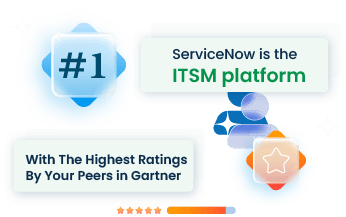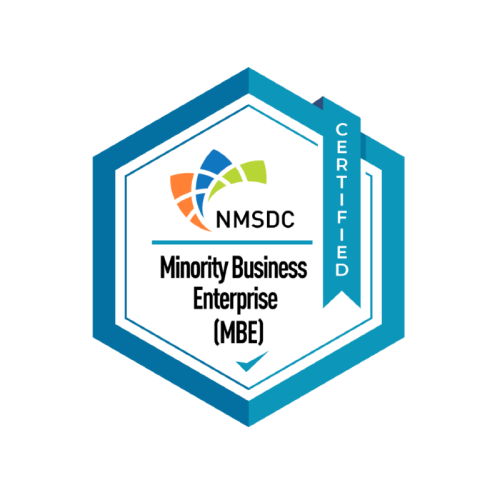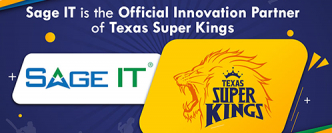“ServiceNow ITSM (Information Technology Service Management) is a cloud-based platform designed to help organizations manage their IT services through a unified and integrated system. It handles key processes such as incident management, service requests, problem resolution, and change management, all within a single, robust platform.
Built on the IT Infrastructure Library (ITIL) framework, ServiceNow ITSM aligns IT services with business goals and follows industry best practices. Its mobile-first design allows teams to track digital workflows from anywhere, simplifying operational control, improving productivity, and streamlining IT service delivery across the organization.
If you are still relying on legacy IT infrastructure, you are likely facing higher costs, operational bottlenecks, and limited scalability. It is time to shift to a modern, cloud-based ITSM solution that simplifies how your business handles IT operations.
ServiceNow ITSM makes this transition smooth. Unlike traditional ITSM tools, it is not just about tracking tickets or managing service requests. It connects every part of your IT service operations to your business goals, giving you better control, faster issue resolution, and a more structured approach to service management.
Why Shift to the Cloud Now?
You know that sticking with outdated systems is holding your business back. Moving to a cloud-based ITSM is not just about keeping up—it is about staying ahead. With ServiceNow ITSM, you can reduce operational risks, cut unnecessary costs, and adapt faster to market changes without worrying about infrastructure limitations.
AI-Powered ITSM That Works for You
Keeping IT operations running efficiently takes more than just good processes—it requires intelligence. ServiceNow uses AI-driven automation to predict issues before they happen, resolve problems faster, and provide actionable insights that help your IT team stay ahead. This means fewer disruptions, quicker resolutions, and a smoother experience for both your employees and customers.
It is time to move past outdated IT service models and take control of your ITSM strategy. With ServiceNow, you get a smarter, faster, and more connected ITSM experience that fits the needs of your business today and prepares you for the future.
ServiceNow ITSM Processes
ServiceNow ITSM provides structured workflows to manage IT services efficiently. By leveraging AI-powered automation, predictive analytics, and self-service capabilities, organizations can enhance service delivery, reduce downtime, and improve operational efficiency. Below is a breakdown of key ITSM processes, their real-world benefits, and their contribution to IT maturity progression.
1. Incident Management: AI-Powered Issue Resolution
Incident Management focuses on promptly addressing and resolving unexpected disruptions in IT services.
Key Benefits:
- Reduced Mean Time to Resolution (MTTR): AI-driven incident categorization and auto-routing decrease resolution times by up to 30% (ServiceNow).
- Predictive Intelligence: Machine learning helps detect patterns, preventing recurring incidents.
- Enhanced User Experience: Faster resolution leads to improved user satisfaction and operational stability.
2. Problem Management: Proactive Issue Prevention
Problem Management identifies and eliminates root causes of incidents to prevent recurrence.
Key Benefits:
- Reduced Incident Volume: By addressing underlying problems, organizations can reduce high-priority incidents by 35%.
- Integrated CMDB Insights: Identifies system dependencies, ensuring proactive issue resolution.
- Automated Workflows: AI-powered problem detection allows IT teams to focus on critical issues.
3. Change Management: Controlled and Risk-Free IT Changes
Change Management ensures that IT changes are executed efficiently while minimizing service disruptions.
Key Benefits:
- Automated Risk Assessment & Approvals: AI auto-approves low-risk changes, reducing manual approvals by 40%.
- Change Advisory Board (CAB) Workbench: A unified interface for tracking and reviewing change requests.
- Reduced Service Downtime: Structured workflows prevent failed changes and ensure compliance.
4. Request Management: AI-Driven Service Fulfillment
Request Management handles IT service requests such as software access, hardware provisioning, and user account creation.
Key Benefits:
- Virtual Agent Automation: AI-powered chatbots handle up to 50% of IT service requests autonomously.
- Self-Service Portals: Users resolve issues independently, reducing IT team workload by 40%.
- Faster Request Fulfillment: AI-driven ticket routing and automation minimize processing times.
ServiceNow’s Alignment with ITSM Frameworks
ServiceNow ITSM helps organizations manage IT services efficiently by following industry-leading frameworks. It automates workflows, strengthens compliance, and improves governance to support IT service management.
How ServiceNow Supports ITIL 4
ServiceNow simplifies IT operations with AI-driven automation:
- Incident & Problem Management: AI classifies tickets and assigns them to the right teams, speeding up resolution.
- Service Request Management: Users can handle requests through self-service with Service Catalog and Virtual Agent integration.
- Change & Release Management: Automated, risk-based change approvals reduce failures and improve agility.
- Configuration Management (CMDB): A service-aware CMDB gives IT teams complete visibility into assets and dependencies.
How ServiceNow Aligns with Other ITSM Frameworks
ServiceNow supports major ITSM frameworks, improving compliance, governance, and service management.
| Framework | How ServiceNow Helps |
|---|---|
| ITIL 4 | Automates Incident, Change, Problem, and Request Management. Uses AI-driven workflows and Virtual Agent for self-service. Manages risk-based change approvals. |
| COBIT | Provides automated policy enforcement for IT governance. Tracks compliance and manages risks with built-in audit tools. |
| ISO/IEC 20000 | Supports ISO 20000-compliant workflows. Uses Service Mapping and CMDB for complete IT visibility. Logs audits and monitors risks to maintain compliance. |
| DevOps | Integrates with Jenkins, GitHub, and Azure DevOps to automate CI/CD workflows. Supports faster, more secure releases. |
| Lean IT | Uses Performance Analytics and Predictive Intelligence to eliminate inefficiencies and optimize IT resources. |
ITSM Maturity & Continuous Improvement
Achieving ITSM Maturity with ServiceNow
ITSM success depends on maturity levels. The Capability Maturity Model Integration (CMMI) and ITIL 4 frameworks define these levels, helping organizations move from basic ticketing to intelligent, AI-driven service management.
ServiceNow ITSM helps businesses build structured workflows, automate tasks, and use AI to improve operations. Instead of reacting to IT issues, companies can predict and prevent problems before they escalate.
ITSM Maturity Levels and ServiceNow’s Role
Every IT organization falls into one of these five maturity levels:
- Initial (Ad-hoc & Reactive): IT teams handle issues with no standard processes.
- Repeatable (Basic ITSM): Some processes exist, but automation and integration are missing.
- Defined (Process-Driven ITSM): Structured workflows align IT services with business goals.
- Managed (Data-Driven ITSM): AI and automation reduce incidents and improve efficiency.
- Optimized (AI-Driven & Predictive ITSM): IT runs with full automation, predictive insights, and business-aligned decision-making.
With ServiceNow ITSM, you can move from firefighting to proactive service management by:
- Centralizing IT operations under one platform.
- Automating repetitive tasks to free up IT teams.
- Using AI to analyze data and predict issues before they happen.
- Tracking key metrics with real-time analytics to improve performance.
Driving Continuous Improvement with ServiceNow
ITSM must evolve with business needs. The Plan-Do-Check-Act (PDCA) cycle helps teams refine processes and improve efficiency.
How ServiceNow ITSM Applies the PDCA Cycle
- Plan: Use Performance Analytics to find inefficiencies and set improvement goals.
- Do: Automate workflows with Virtual Agent, AI-driven routing, and IntegrationHub.
- Check – Track KPIs in Performance Analytics to measure efficiency gains.
- Act – Optimize based on AI-generated recommendations and user feedback.
ServiceNow’s built-in tools support this cycle:
- Predictive Intelligence: Uses historical data to categorize issues and suggest solutions.
- IntegrationHub: Connects ITSM with third-party applications for faster execution.
- Process Optimization Tools: Identify weak points and recommend workflow improvements.
Advancing ITSM Maturity with AI & Automation
To move beyond traditional ITSM, businesses can leverage AI and automation in ServiceNow ITSM:
- Incident Prediction: AI detects risks and flags them before they cause disruptions.
- Automated Change Management: AI assesses risks and helps teams make better decisions.
- Self-Service Virtual Agents: Employees resolve IT issues instantly without contacting support.
ServiceNow ITSM provides a clear path from reactive IT management to predictive operations, helping teams reduce downtime, improve service delivery, and simplify IT processes.
ServiceNow’s Alignment with Other ITSM Frameworks
ServiceNow also aligns with other major ITSM frameworks to enhance governance, compliance, and IT operations.
ServiceNow ITSM Tool Features
1. Predictive Intelligence
ServiceNow’s Predictive Intelligence uses machine learning to automate routine tasks, making IT service management faster and more accurate.
How it helps you:
- Categorize and assign incidents instantly: It analyzes past incidents, classifies them, and sends them to the right teams—reducing response times and ensuring experts handle each issue.
- Predict service demand: It studies service request patterns, forecasts future demand, and helps you allocate resources efficiently.
2. Performance Analytics
ServiceNow’s Performance Analytics gives you real-time insights through customizable dashboards, helping you track key performance indicators (KPIs) and make informed decisions.
What you get:
- Ready-to-use dashboards: ServiceNow provides built-in dashboards for IT Service Management (ITSM), showing key metrics for incident management, change management, and service requests.
- Track trends over time: Identify patterns, refine strategies, and continuously improve processes with time series analysis.
3. Mobile Accessibility
ServiceNow ITSM lets you manage and resolve incidents from anywhere with full mobile access.
How it works for you:
- Resolve incidents on the go: Get real-time notifications, check details, and take action immediately using the ServiceNow Mobile Agent app. Faster response times mean better service continuity.
- Approve requests instantly: Managers can review and approve change or service requests from their mobile devices, keeping workflows moving without delays.
4. Knowledge Management
ServiceNow’s Knowledge Management helps you organize and share information across your organization, improving self-service and support efficiency.
What you can do:
- Empower users with self-service: Employees and customers access a centralized knowledge base to find answers, reducing support tickets and resolving issues faster.
- Support agents find answers quickly: Agents can search for relevant articles instantly, provide accurate information, and improve first-call resolution rates.
AI & Automation Features in ServiceNow ITSM
AI-Powered Incident Resolution
- Uses Predictive Intelligence to auto-categorize, route, and prioritize incidents based on historical data.
- Reduces manual effort by automatically assigning tickets to the right resolution teams.
- Virtual Agent assists employees with IT issues 24/7, resolving common requests without human intervention.
Automation with IntegrationHub
- Automates password resets, account provisioning, and client software distribution.
- Connects ITSM with third-party applications (e.g., Microsoft Teams, Jira, Azure DevOps).
- Triggers ITSM workflows to initiate external system actions, reducing ticket resolution time.
AI-Driven Analytics & Decision-Making
- Proactive trend analysis using Performance Analytics to identify service bottlenecks before they escalate.
- AI-powered anomaly detection helps IT teams resolve issues before they impact users.
- Data-driven insights improve IT decision-making for capacity planning and resource allocation.
How to Implement ServiceNow ITSM In Your Business
1. Preparation and Planning
Many ITSM implementations fail due to unclear objectives, lack of stakeholder buy-in, and inadequate risk assessment. Proper planning ensures a strategic, scalable, and cost-effective ITSM adoption.
Best Practices for ITSM Planning
Define Business Goals with IT Alignment
- Map ITSM objectives to business priorities like service quality, cost reduction, and compliance.
- Avoid generic goals—be specific (e.g., “Reduce incident resolution time by 30% in 6 months”).
Strategic Project Scope Definition
- Identify essential ITSM processes (Incident, Change, Asset Management) for initial rollout.
- Plan a phased implementation instead of an all-at-once deployment to reduce disruption.
Build a Cross-Functional ITSM Team
- Include IT leadership, ServiceNow admins, and business unit representatives.
- Assign a dedicated governance role for process oversight.
2. Leverage Out-of-the-Box (OOTB) Functionality
Over-customization causes most ITSM failures, increasing costs, maintenance overhead, and upgrade issues. ServiceNow ITSM includes pre-configured workflows that follow ITIL best practices, reducing risks and speeding up deployment.
Best Practices for Implementation
Adopt Standard Processes
- Use built-in workflows for incident, change, and problem management to reduce unnecessary customizations.
- Ensure all ITSM processes adhere to ITIL best practices for standardized operations.
Minimize Customization Risks
- Over-customization introduces technical debt, making upgrades difficult.
- Evaluate custom requirements using the “80-20 Rule” – if 80% of needs are met by OOTB features, avoid customization.
Use Pre-Built Tools for Efficiency
- ServiceNow provides ready-to-use templates, process models, and automation scripts to simplify deployment and workflow optimization.
- Utilize OOTB integrations to reduce development time and system inconsistencies.
3. Requirement Analysis
Inadequate requirement gathering leads to misaligned ITSM workflows, excessive customization, and user adoption resistance. A structured requirement analysis phase prevents these issues.
Best Practices for ITSM Requirement Analysis
Stakeholder-Driven Requirement Collection
- Conduct structured interviews & surveys with IT staff, service desk teams, and end-users.
- Identify recurring pain points in current service management workflows.
Gap Analysis Between ITIL Best Practices & Current IT Operations
- Compare existing ITSM workflows vs. ITIL frameworks to identify inefficiencies.
- Assess whether OOTB ServiceNow features can bridge the gap.
Define Measurable Success Metrics (KPIs)
- Track success using quantifiable ITSM performance indicators:
- Mean Time to Resolution (MTTR)
- Reduction in open incident backlog
- Decrease in IT service downtime
4. System Design
Poor ITSM system design results in workflow inefficiencies, bottlenecks, and data silos. A well-architected ITSM framework ensures scalability and automation.
Best Practices for ITSM System Design
Process Mapping for Core ITSM Workflows
- Visualize workflows for incident, problem, change, and request management.
- Identify automation opportunities to reduce manual intervention and errors.
Optimize User Interface & Service Experience
- Simplify UI elements to improve usability and efficiency for service desk agents.
- Remove redundant steps that increase ticket handling time.
Integration with Third-Party Systems & Legacy Apps
- Use ServiceNow Integration Hub to connect ITSM with: seamlessly
- ERP systems for asset tracking
- Collaboration tools like Slack & Teams
- Cloud platforms for real-time service synchronization
5. Configuration and Customization
Too much customization makes systems harder to manage, drives up maintenance costs, and complicates upgrades. With ServiceNow’s configuration-first approach, you get faster deployment, easier scalability, and built-in ITIL compliance—all without the headaches of excessive modifications.
Best Practices for Implementation
Use Pre-Built ServiceNow Modules
- Configure ITSM processes using OOTB templates to maintain compatibility with upgrades.
- Leverage ServiceNow Flow Designer to automate incident, request, and change management workflows.
Apply Minimal Customization for Business-Critical Needs
- Use low-code/no-code options where possible.
- Any custom scripts should follow ServiceNow’s Development Guidelines for scalability and security.
Establish a Configuration Governance Model
- Define approval workflows for changes.
- Assign configuration owners to oversee ITSM stability and compliance.
6. Testing and Validation
Testing keeps your ITSM system stable, protects data integrity, and ensures everything works together smoothly. Skipping structured testing can lead to misconfigurations, data migration issues, or broken workflows.
Best Practices for Implementation
Develop a Multi-Layered Test Strategy
- Unit Testing – Validate each configured component independently.
- System Testing – Ensure end-to-end ServiceNow workflows function correctly.
- Performance Testing – Simulate real-world loads to prevent slowdowns.
Perform User Acceptance Testing (UAT) with Key Stakeholders
- Engage IT teams and business users to test real-world scenarios before full deployment.
- Use test automation to validate incident routing, approvals, and SLAs.
Ensure Data Accuracy in Migrations
- Conduct pre-migration data cleansing to avoid transferring obsolete records.
- Validate data mappings against live production data to prevent inconsistencies.
7. Invest in Training and Change Management
The most technically sound ITSM implementations fail due to poor user adoption. Ensuring structured training and change management leads to higher adoption rates and operational efficiency.
Best Practices for User Training
Role-Based Training Programs
- Design training modules tailored to IT leaders, service desk agents, and administrators.
- Use real-world scenarios instead of theoretical training to improve retention.
On-Demand Learning for Continuous Improvement
- Leverage ServiceNow Learning Paths, documentation, and internal knowledge bases.
- Conduct quarterly refresher workshops to reinforce best practices.
Change Management Framework to Reduce Resistance
- Common Issue: Employees resist new tools due to fear of workflow disruption.
- Solution: Implement a structured change communication strategy:
- Phase 1: Awareness Campaign → Explain why ServiceNow ITSM is being implemented.
- Phase 2: Early Testing with Pilot Teams → Get initial feedback & early adopters.
- Phase 3: Company-Wide Rollout → Offer support resources like helpdesks and on-demand training.
8. Go-Live and Support
A phased deployment strategy reduces disruptions, this approach helps teams spot and fix issues early before fully rolling out the system.
Best Practices for Go-Live
Execute a Phased Rollout
- Deploy incident management first, then problem, change, and request management.
Monitor Performance in Real-Time
- Track adoption rates, process efficiencies, and incident resolutions using ServiceNow dashboards.
Set Up a Dedicated Support Desk
- Provide tiered support teams trained to troubleshoot ITSM issues post-launch.
9. Establish Strong Governance and Compliance
Without governance, ITSM implementations can spiral into inefficiencies, leading to data security issues, mismanaged workflows, and operational inconsistency.
Best Practices for ITSM Governance
Define Clear Governance Policies
- Create an ITSM governance committee responsible for:
- Change approvals & risk assessments.
- ITIL framework alignment & compliance tracking.
- Periodic system audits & optimization reviews.
Assign Process Ownership
- Assign ITSM process owners for each key function (incident management, problem resolution, asset tracking).
- Ensure they have visibility into ServiceNow analytics dashboards for real-time tracking.
Conduct Regular Audits and Optimization Reviews
- Perform quarterly ITSM health checks to:
- Identify process inefficiencies.
- Ensure compliance with internal policies & regulatory standards (ISO 20000, ITIL).
- Use ServiceNow’s AI-powered analytics to track service requests, incident trends, and automation efficiency.
10. Continuous Improvement
ServiceNow ITSM is a dynamic platform that evolves with business needs. Without regular optimization, organizations risk stagnation, inefficiencies, and a decline in ITSM performance.
Best Practices for Ongoing ITSM Enhancement
Collect User Feedback for Refinement
- Implement a feedback loop where employees can suggest improvements to ITSM workflows.
- Conduct quarterly ITSM performance evaluations to track adoption rates and identify pain points.
Regularly Review and Optimize ITSM Processes
- Use ServiceNow’s AI-driven analytics to detect inefficiencies in incident management and service request workflows.
- Automate repetitive tasks using ServiceNow IntegrationHub to boost IT productivity.
Stay Updated with ServiceNow Enhancements
- Enroll IT teams in ServiceNow’s upgrade webinars to understand new features and capabilities.
- Align ITSM configurations with latest ServiceNow platform releases to maximize efficiency.
ServiceNow ITSM Integrations
Integration Capabilities
ServiceNow ITSM offers seamless integration with various tools and platforms, enhancing its functionality and providing a cohesive IT service management experience. These integrations enable ServiceNow to connect with other systems, facilitating data exchange, workflow automation, and improved operational efficiency.
Popular Integrations and Their Benefits
ServiceNow ITSM offers seamless integration with various tools and platforms, enhancing its functionality and providing a cohesive IT service management experience. These integrations enable ServiceNow to connect with other systems, facilitating data exchange, workflow automation, and improved operational efficiency.
- Jira: Integrates ServiceNow with Jira to streamline issue tracking and resolution. This integration allows automatic ticket creation in Jira when a ServiceNow incident is logged, ensuring swift communication between development and IT teams.
- Slack: Connects ServiceNow with Slack to enable real-time collaboration. This integration allows users to manage incidents and requests directly from Slack, reducing response times and enhancing team communication.
- Microsoft Teams: Allows users to create and manage ServiceNow tickets within Microsoft Teams. This integration helps in streamlining workflows and improving productivity by keeping all communications in one place.
- Azure DevOps: Integrates ServiceNow with Azure DevOps to bridge the gap between IT operations and development. This integration facilitates seamless release management, ensuring that updates and patches are deployed smoothly.
- Active Directory: Syncs user data between ServiceNow and Active Directory, automating user management tasks such as provisioning and deprovisioning accounts.
Employee Experience with ServiceNow ITSM Modules
1. Service Portal – Your Self-Service IT Hub
Waiting for IT support slows you down. The ServiceNow Service Portal gives you direct access to IT requests, solutions, and information—all in one place.
Find What You Need—Fast
Navigate quickly with an intuitive interface that helps you locate solutions without switching between multiple systems.
Resolve IT Issues On Your Own
Skip the IT wait time. Submit requests, access knowledge articles, and track service progress in just a few clicks.
Customize to Match Your Business Needs
Modify the Service Portal to fit your branding, workflows, and service catalog, creating a tailored IT experience.
The Service Portal reduces IT workload, speeds up service delivery, and improves user satisfaction.
2. Virtual Agent
The ServiceNow Virtual Agent, powered by AI, instantly responds to IT service requests and automates repetitive tasks.
✔ Provides 24/7 Support – Employees get immediate assistance anytime.
✔ Resolves Issues Automatically – Handles password resets, system access, and FAQs without human involvement.
✔ Connects Across Platforms – Works with ServiceNow applications and third-party tools to deliver accurate responses.
The Virtual Agent reduces IT workload, speeds up response times, and improves support availability.
3. Mobile ITSM
ServiceNow’s Mobile ITSM solutions put IT services in the hands of employees and IT teams, allowing them to manage IT tasks from anywhere.
✔ IT teams stay in control – They handle incidents, approve requests, and keep track of on-call schedules from anywhere.
✔ Employees get things done faster – They can submit requests, check statuses, and chat with the Virtual Agent right from their phones.
✔ Real-time notifications keep everyone updated – Users instantly know about approvals, service requests, and resolutions.
Mobile ITSM puts IT support right where you need it, helping teams work smarter and stay connected.
ServiceNow vs. Competitors: Why ServiceNow Leads the ITSM Market
Over 400+ ITSM platforms compete for business, but ServiceNow dominates with AI-driven automation, predictive intelligence, and enterprise-grade IT operations. Gartner ranks ServiceNow as the top ITSM platform, leaving BMC, Ivanti, and TOPdesk behind.
How does ServiceNow compare?
Quick Feature Comparison Table
| Feature | ServiceNow | BMC | Ivanti | TOPdesk |
|---|---|---|---|---|
| AI & Automation | Predictive Intelligence, AI-driven workflows | Limited automation | Basic AI features | No AI capabilities |
| Cloud-Based | Fully cloud-native | Transitioning from on-prem | Hybrid (Cloud + On-prem) | Cloud-first but lacks enterprise scale |
| CMDB & ITOM | Unified ITOM, automated asset mapping | Requires extra setup | Basic asset tracking | No deep ITOM capabilities |
| User Interface | Low-code, intuitive workflows | Complex UI, steep learning curve | Simple UI, lacks depth | Easy to use, but limited for enterprises |
| Integration & APIs | Pre-built integrations for ITOM, DevOps, Security | Requires additional customization | Limited third-party support | Basic integrations, not enterprise-grade |
Gartner’s View on ServiceNow
“Gartner’s Magic Quadrant ranks ServiceNow as the industry leader in ITSM. Businesses trust ServiceNow for its AI-driven automation, advanced analytics, and a scalable ITSM ecosystem—outpacing competitors like BMC, Ivanti, and TOPdesk.”
Detailed Comparison
ServiceNow vs. BMC
- AI vs. Legacy ITSM: ServiceNow uses predictive intelligence and workflow automation to speed up IT operations, while BMC still relies on manual processes.
- Modern vs. Complex Interface: ServiceNow’s low-code architecture lets teams set up ITSM faster, while BMC demands heavy customization.
- Better Integration: ServiceNow connects ITOM, SecurityOps, and DevOps without extra setup, while BMC users struggle with complex configurations.
- Scalability & Flexibility: Large businesses move beyond basic ticketing with ServiceNow, while BMC customers often outgrow its capabilities.
Why Businesses Choose ServiceNow Over BMC: ServiceNow eliminates IT service bottlenecks and scales IT operations with AI-driven automation.
ServiceNow vs. Ivanti
- One System vs. Disconnected Tools: ServiceNow combines ITSM, ITOM, ITAM, and AI in one platform. Ivanti forces businesses to manage separate tools for each function.
- Predictive AI vs. Basic Automation: ServiceNow automates incident categorization, routing, and resolution, while Ivanti only offers basic automation.
- Enterprise vs. Mid-Market Focus: Fortune 500 companies trust ServiceNow for large-scale ITSM, while Ivanti suits smaller businesses.
Why Enterprises Pick ServiceNow Over Ivanti: ServiceNow supports global IT operations with AI and automation, while Ivanti falls short in enterprise-level ITSM.
ServiceNow vs. TOPdesk
- Enterprise-Grade vs. Mid-Market ITSM: ServiceNow serves large enterprises with AI-powered automation, while TOPdesk focuses on mid-sized businesses.
- Advanced Analytics vs. Basic Reporting: ServiceNow delivers real-time insights and machine learning-driven reporting, while TOPdesk lacks deep analytics.
- Scalability & Integration: ServiceNow connects third-party apps and enterprise systems, while TOPdesk’s limited integrations hold businesses back.
Why Companies Upgrade from TOPdesk to ServiceNow: ServiceNow goes beyond basic service management, giving enterprises real-time analytics and AI-powered workflows.
Benefits of ServiceNow ITSM
ServiceNow ITSM provides valuable advantages suitable to different groups within an organization, confirms an all-encompassing improvement of IT service management.
For Businesses
- Boosted productivity due to automated workflows, minimizing the need for manual intervention.
- Cost reduction from improved resource allocation and fewer service disruptions.
- improved decision-making from real-time analytics and comprehensive reporting.
For IT Departments
- Streamlined processes resulting in quicker issue resolution and minimal service downtime.
- Superior resource management through automated asset tracking and optimized service delivery.
- Centralized platform for managing all IT services, improving collaboration and transparency.
For Users/Employees
- Better user experience with a more intuitive interface and faster service request fulfillment.
- Higher satisfaction due to prompt support and consistent service quality.
- Increased engagement from a more responsive and user-friendly IT service platform.
Industry-Specific Benefits of ServiceNow ITSM
Finance
Financial institutions struggle with compliance audits, risk management, and security breaches. Manual tracking leads to regulatory fines and operational delays.
Automate compliance tracking, risk assessments, and security policies with ServiceNow’s Risk and Compliance Management module. Stay aligned with SOX and PCI-DSS regulations without extra manual effort.
Predict and prevent service outages with AI-driven workflows. ServiceNow ITSM routes incidents to the right teams, reducing downtime in online banking and payment processing.
Healthcare
Healthcare IT teams handle patient records, electronic health systems, and emergency support. Slow IT resolutions delay medical services, affecting patient care.
Integrate patient management systems with ServiceNow ITSM to track and resolve IT issues faster.
Secure patient data with role-based access control (RBAC) and automated logs, making HIPAA compliance easy.
Retail
Retailers need real-time IT support, asset tracking, and reliable POS operations. IT failures cause lost sales and frustrated customers.
Monitor and manage IT assets across multiple locations with ServiceNow IT Asset Management. Prevent system failures before they happen.
Give employees AI-powered self-service IT support with Virtual Agents using Natural Language Understanding (NLU).
Government
Government agencies process thousands of service requests daily. Outdated systems slow down response times.
Automate case management workflows and cut down manual tasks. ServiceNow ITSM speeds up public service response times.
Monitor IT performance with real-time tracking in the Compliance Dashboard. Stay compliant with FedRAMP, NIST, and ISO 20000.
Utilities
Utility companies need proactive monitoring to prevent service disruptions. Waiting for failures increases costs and downtime.
Monitor infrastructure in real time with ServiceNow ITOM. Detect issues before they impact service.
Use AI-powered analytics to schedule maintenance, fixing problems before they cause disruptions.
Pharmaceuticals
Pharmaceutical companies deal with strict compliance rules and complex R&D workflows. Manual documentation slows down research.
Automate compliance documentation with ServiceNow R&D Workflows. Reduce delays in clinical trials.
Keep audit-ready compliance records with GxP Compliance Management. Meet FDA and global regulatory standards without the hassle.
Costs for Implementing ServiceNow ITSM
Software Licensing
ServiceNow offers IT Service Management (ITSM) solutions designed to support businesses of various sizes and complexity levels. The platform is available in three tiers:
| Feature | Standard | Professional | Enterprise |
|---|---|---|---|
| Incident, Problem, Change, Request Management | ✅ | ✅ | ✅ |
| Release Management | ✅ | ✅ | ✅ |
| Cost Management | ✅ | ✅ | ✅ |
| Asset Request Management | ✅ | ✅ | ✅ |
| Walk-Up Experience | ✅ | ✅ | ✅ |
| Notify (Notification Management) | ✅ | ✅ | ✅ |
| Performance Analytics | ❌ | ✅ | ✅ |
| Continual Improvement Management | ❌ | ✅ | ✅ |
| Agent Intelligence (AI & ML) | ❌ | ✅ | ✅ |
| ServiceNow Virtual Agent | ❌ | ✅ | ✅ |
| Vendor Manager Workspace | ❌ | ✅ | ✅ |
| Service Owner Workspace | ❌ | ✅ | ✅ |
| Dynamic Translation (Premium Feature) | ❌ | ✅ | ✅ |
| Unrestricted User Model | ❌ | ✅ | ✅ |
To get a customized quote that fits your business needs, contact ServiceNow directly.
Return on Investment (ROI)
Organizations using ServiceNow ITSM have reported:
- 195% ROI over three years.
- 20% higher IT productivity by reducing manual tasks.
- 25% fewer Priority 1 incidents, cutting downtime.
- $17.3 million in present value benefits from automation and efficiency gains.
Explore real-world results on ServiceNow’s customer stories page to see how businesses have improved IT operations.
Evaluate your ITSM requirements and consult our ServiceNow consulting experts to improve implementation, reduce costs, and increase operational efficiency. Our team is ready to assist if you need help selecting the right ITSM package, configuring workflows, or optimizing system performance.
Conclusion
ServiceNow ITSM can bring remarkable changes to your IT operations, making them smoother and more responsive. It helps in reducing downtime and improving service delivery, leading to better user satisfaction.
Navigating the implementation and setup of ServiceNow ITSM can be challenging. This is where Sage IT comes in. Our ServiceNow consulting service offers deep technical knowledge and hands-on experience to guide you through every step. We customize solutions to meet your unique needs, ensuring you gain the full benefits of your ServiceNow system.
Our expert consultants are here to support you, helping drive success and improvement for your business.











